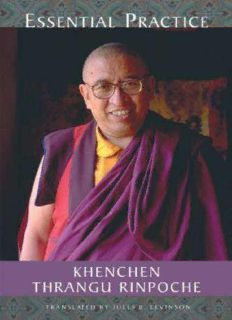
Essential Practice: Lectures on Kamalashila's Stages of Meditation in the Middle Way School PDF
Preview Essential Practice: Lectures on Kamalashila's Stages of Meditation in the Middle Way School
by Khenchen Thrangu Rinpoche Translated by Jules B. Levinson This work is dedicated to the Seventeenth Gyalwang Karmapa, Urgyen Droddl Trinley Dorje Introduction I Technical Note 4 Acknowledgments 5 PART 1: First Treatise on the Stages of Meditation 7 Chapter One: Kamalashila, Compassion, and the Mind of Awakening 9 Chapter Two: Practice 19 Chapter Three: Contemplation 31 Chapter Four: Calm Abiding 43 Chapter Five: Insight 55 Chapter Six: Certainty 65 Chapter Seven: Meditative Stabilization 77 Chapter Eight: The Ten Grounds of Bodhisattvas and the Ground of a Buddha 89 PART z: Intermediate Treatise on the Stages of Meditation roi Chapter One: Compassion 103 Chapter Two: The Mind of Awakening and the Causes of Calm Abiding 117 Chapter Three: The Causes of Insight 131 Chapter Four: The Selflessness of Persons 143 Chapter Five: The Selflessness of Phenomena 157 Chapter Six: The Six Transcendent Actions 171 Chapter Seven: The Fruit of Realization 187 Notes 199 Glossary 205 List of Works Cited 213 N THE SPRING OF 1988, the Ven. Thrangu Rinpoche traveled from his home in Kathmandu, Nepal, to Boulder, Colorado, where, at the invitation of the President and Faculty of the Naropa Institute, he gave a series of lectures on the Indian master Kamalashila's First Treatise on the Stages ofMeditation in the Middle Way School. He returned to the Institute in the fall of 1989 and gave a second series of lectures, this time focusing upon Kamalashila's Intermediate Treatise on the Stages ofMeditation in the Middle Way School A few words here may help readers to understand the style of the instructions he gave then and the style of the translations I have made now. All sorts of people came to these talks. On any given evening, the listeners would include students enrolled in the Naropa Institute's program in Buddhist Studies as well as students focusing upon other areas of the arts and humanities, faculty representing the full range of the Institute's various departments, numerous members of Boulder's sizeable Buddhist community, and the merely curious, carried in by serendipity. Some of those who came to the lectures brought with them more than a few years of study and practice in Buddhist communities; some may have known only that a fellow with a big smile had come a long way to speak freely about wisdom. The diverse audience provided a responsive canvas upon which to portray the view, meditation, and conduct taught in the Great Vehicle (mahdydna) of the Buddhadharma. Aiming to convey a clear and accessible account of Kamalashila's treatises that would prove handy to practitioners of the Buddhadharma, Thrangu Rinpoche weaves many layers of scholastic expertise into an unruffled instruction. Rather than comment closely upon individual words and recalcitrant passages, he focuses upon the themes of Kamalashila's essays and brings them into plain view. A reader of Kamalashila's treatises will nevertheless find in these lectures the precision and guidance required for the navigation of a complex Buddhist treatise. Thrangu Rinpoche seems to hover gracefully just above the text, listening carefully to its melody, savoring the beauty and drama of its story, and then turning to us, his students, with whom he happily shares the meaning lifted lightly from an ancient heritage. As his translator on the occasion of these lectures, I marveled as the master worked his art, opening the palm fully, lavishing treasure upon the unsuspecting, beguiling all, disappointing none. In translating these lectures, I have tried to remain faithful to Thrangu Rinpoche's tone and manner. I started from scratch by listening to the recordings that were made at the time and translating every word, aiming for accuracy and completeness. On the next round, I listened to the tapes again and looked hard at the English; wouldn't it be nice if the pleasure of listening to Thrangu Rinpoche were to come through? I hope that his many students will recognize the voice of their teacher in these translations. At minimum, readers will come away with a sense of how a veteran teacher of the Buddhadharma unfolds a passionate insight stage by stage. Thrangu Rinpoche gave the first series of lectures one year after the death of Chogyam Trungpa, Rinpoche, the charismatic founder of the Naropa Institute and a lifelong friend of Thrangu Rinpoche, alongside whom he had received ordination from the Sixteenth Gyalwang Karmapa, Ranjung Rigpe Dorje, at a young age. As a community, we stepped uncertainly into the void left by the death of our teacher. We found inspiration in the strength of heart and easy confidence, both in the Buddhadharma and in us, that Thrangu Rinpoche demonstrated on the occasion of these lectures; we look for words that will express our gratitude adequately but fail to find them. In lecturing on Kamalashila's treatises outlining the stages of meditation practiced in the Middle Way School, Thrangu Rinpoche remarked that "these treatises were composed newly in order to help the people of Tibet when the teachings of the Buddha were initially being established in Tibet. Now, because the teachings of the Buddha are beginning to flourish in America, I thought it would be helpful if I were to present these treatises, which are not like others." Some who study these instructions will be embarking freshly upon this noble journey. Others may feel that, after an extensive immersion in Buddhist teaching and Buddhist practice, they have at last come to the beginning of the path. Either way, a beginner's delight and a beginner's humility fit well with the accessible and authoritative portrait given here of a bodhisattva's view, meditation, and conduct. This record of a masterful teacher's instructions will help students old and new to determine what is essential to the practice of the Buddhadharma and
Description: